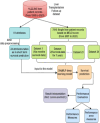Advanced prognostic modeling with deep learning: assessing long-term outcomes in liver transplant recipients from deceased and living donors
- PMID: 39956905
- PMCID: PMC11830213
- DOI: 10.1186/s12967-025-06183-1
Advanced prognostic modeling with deep learning: assessing long-term outcomes in liver transplant recipients from deceased and living donors
Abstract
Background: Predicting long-term outcomes in liver transplantation remain a challenging endeavor. This research aims to harness the power of deep learning to develop an advanced prognostic model for assessing long-term outcomes, with a specific focus on distinguishing between deceased and living donor transplantation.
Methods: A comprehensive dataset from UNOS encompassing clinical, demographic, and transplant-related variables of liver transplant recipients from deceased and living donors was utilized. The main dataset has been transformed into Deceased Donor-Recipient and Living Donor-Recipient dataset. After manual extraction, the dimensionality reduction was performed with Principal component analysis in both datasets and top ranked 23 attributes were collected. A Deeplearning4j Multilayer Perceptron classifier has been employed and long-term survival analysis has been conducted with the help of liver follow-up data. The performance evaluation is done separately in datasets and evaluated the survival probabilities of 23 years.
Results: UNOS database comprises 410 attributes and 353,589 records from 1998 to 2023. The outcome from the deep learning model was compared with actual graft survival to ensure the accuracy. The model trained 23 attributes and obtained Sensitivity, Specificity and accuracy values were 99.9, 99.9 and 99.91% using R-Living donor dataset. The Sensitivity, Specificity and Accuracy value obtained using R-Deceased donor dataset were 99.7, 99.7 and 99.86%. The short term and long-term survival prediction after liver transplantation has been done successfully with Dl4jMLP classifier with appropriate selection of attributes irrespective of donor type. This study's finding suggesting that the distinction between deceased and living donor transplantation does not significantly affect survival prediction after liver transplantation is noteworthy.
Conclusions: The utility of the Deeplearning4j model in survival prediction after liver transplantation has been validated in this study. Based on the findings, deceased donor transplantation could be promoted over living donor transplantation.
Keywords: Deceased donor; Deep learning; Liver transplantation; Living donor; Prediction; Survival.
© 2025. The Author(s).
Conflict of interest statement
Declarations. Ethics approval and consent to participate: The data were collected based on OPTN data as on 5th June 2015. This work was supported in part by Health Resources and Services Administration contract 234–2005-370011C. The content is the responsibility of the authors alone and does not necessarily reflect the views or policies of the Department of Health and Human Services, nor does the mention of trade names, commercial products, or organizations imply endorsement by the U.S. Government. Consent for publication: All authors approved the publication of this manuscript. Competing interests: The authors declare no competing interests.
Figures






References
-
- Raji CG, Safna AK. Computational methods for predicting the outcome of thoracic transplantation. J Big Data. 2022;9(1):58.
-
- Kargar B, Gazerani VG, Pishvaee MS. Predicting liver transplantation outcomes through data analytics. In: Bohlouli M, Bigham BS, Narimani Z, Vasighi M, Ansari E, editors. Data science: from research to application. Cham: Springer International Publishing; 2020. p. 142–60.
MeSH terms
Grants and funding
LinkOut - more resources
Full Text Sources
Medical

